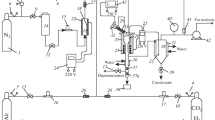An investigation has been made into accelerated hydrothermal fluidized carbonization of sewage sludge in a superheated steam medium. It is shown that an increase in the process temperature has no effect on its duration but has a significant effect on the composition of noncondensable gases. Biochar activation has been investigated in potassium hydroxide at a temperature of 750°C and the biochar–KOH ratios of 1:1.5, 1:2, and 1:3. It is shown that the KOH concentration has no effect, in practice, on the sorption characteristics of the obtained product which is more suitable for the use as a soil improver.
Similar content being viewed by others
References
S. Khan, N. Wang, B. J. Reid, A. Freddo, and C. Cai, Reduced bioaccumulation of PAHs by Lactuca satuva L. grown in contaminated soil amended with sewage sludge and sewage sludge derived biochar, Environ. Pollut., 175, 64–68 (2013).
X. Yuan, H. Huang, G. Zeng, H. Li, J. Wang, C. Zhou, H. Zhu, X. Pei, Z. Liu, and Z. Liu, Total concentrations and chemical speciation of heavy metals in liquefaction residues of sewage sludge, Bioresour. Technol., 102, No. 5, 4104–4110 (2011).
C. He, A. Giannis, and J. Wang, Conversion of sewage sludge to clean solid fuel using hydrothermal carbonization: Hydrochar fuel characteristics and combustion behavior, Appl. Energy, 111, 257–266 (2013).
C. Peng, Y. Zhai, Y. Zhu., B. Xu, T. Wang, C. Li, and G. Zeng, Production of char from sewage sludge employing hydrothermal carbonization: Char properties, combustion behavior and thermal characteristics, Fuel, 176, 110–118 (2016).
Y. Zhai, H. Chen, B. Xu, B. Xiang, Z. Chen, C. Li, and G. Zeng, Influence of sewage sludge-based activated carbon and temperature on the liquefaction of sewage sludge: Yield and composition of bio-oil, immobilization and risk assessment of heavy metals, Bioresour. Technol., 159, 72–79 (2014).
L. Leng, X. Yuan, J. Shao, H. Huang, H. Wang, H. Li, X. Chen, and G. Zeng, Study on demetalization of sewage sludge by sequential extraction before liquefaction for the production of cleaner bio-oil and bio-char, Bioresour. Technol., 200, 320–327 (2016).
P. Zhao, Y. Shen, S. Ge, Z. Chen, and K. Yoshikawa, Clean solid biofuel production from high moisture content waste biomass employing hydrothermal treatment, Appl. Energy, 131, 345–367 (2014).
R. Dewil, J. Baeyens, and L. Appels, Enhancing the use of waste activated sludge as bio-fuel through selectively reducing its heavy metal content, J. Hazard. Mater., 144, No. 3, 703–707 (2007).
T. Chen, Z. Zhou, S. Xu, H. Wang, and W. Lu, Adsorption behavior comparison of trivalent and hexavalent chromium on biochar derived from municipal sludge, Bioresour. Technol., 190, 388–394 (2015).
A. Méndez, J. Paz-Ferreiro, F. Araujo, and G. Gascó, Biochar from pyrolysis of deinking paper sludge and its use in the treatment of a nickel polluted soil, J. Anal. Appl. Pyrolysis, 107, 46–52 (2014).
A. Zielinska and P. Oleszczuk, Evaluation of sewage sludge and slow pyrolyzed sewage sludge-derived biochar for adsorption of phenanthrene and pyrene, Bioresour. Technol., 192, 618–626 (2015).
W. Shi, C. Liu, D. Ding, Z. Lei, Y. Yang, C. Feng, and Z. Zhang, Immobilization of heavy metals in sewage sludge by using subcritical water technology, Bioresour. Technol., 137, 18–24 (2013).
L. Leng, X. Yuan, H. Huang, H. Jiang, X. Chen, and G. Zeng, The migration and transformation behavior of heavy metals during the liquefaction process of sewage sludge, Bioresour. Technol., 167, 144–150 (2014).
H. Pan, Effects of liquefaction time and temperature on heavy metal removal and distribution in liquefied CCA-treated wood sludge, Chemosphere, 80, No. 4, 438–444 (2010).
R. L. Isemin, A. V. Mikhalev, N. S. Muratova, V. S. Kogh-Tatarenko, Yu. S. Teplitskii, E. K. Buchilko, A. Zh. Greben’kov, and E. A. Pitsukha, Improving the efficiency of biowaste torrefaction, Therm. Eng., 66, No. 7, 521–526 (2019).
P. J. Arauzo, P. A. Maziarka, M. P. Olszewski, R. L. Isemin, N. S. Muratova, F. Ronsse, and A. Kruse, Valorization of the poultry litter through wet torrefaction and different activation treatments, Sci. Total Environ., 732, Article 139288 (2020).
B. Ghanim, D. Pandey, W. Kwapinski, and J. Leahy, Hydrothermal carbonization of poultry litter: Effects of treatment temperature and residence time on yields and chemical properties of hydrochars, Bioresour. Technol., 216, 373–380 (2016).
V. I. Kovenskii, V. A. Borodulya, Yu. S. Teplitskii, G. I. Pal’chenok, and D. S. Slizhuk, Modeling of superheated-steam drying of biofuel in a fl uidized bed, J. Eng. Phys. Thermophys., 83, No. 4, 764–769 (2010).
Author information
Authors and Affiliations
Corresponding author
Additional information
Translated from Inzhenerno-Fizicheskii Zhurnal, Vol. 94, No. 6, pp. 1591–1596, November–December, 2021.
Rights and permissions
About this article
Cite this article
Muratova, N.S., Is’emin, R.L., Melezhik, A.V. et al. Results of Chemical Activation of Biochar Obtained by the Method of Accelerated Hydrothermal Carbonization of Sewage Sludge. J Eng Phys Thermophy 94, 1557–1562 (2021). https://doi.org/10.1007/s10891-021-02436-0
Received:
Published:
Issue Date:
DOI: https://doi.org/10.1007/s10891-021-02436-0




